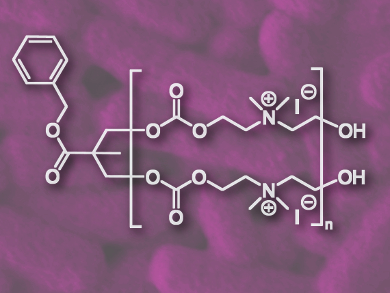The resistance of bacteria against antibiotic drugs is a growing problem. Multidrug-resistant pathogens, in particular, are a serious danger to human health. New antimicrobial compounds need to be developed to keep these bacteria in check. In addition, bacteria often form biofilms, in which the bacteria stick together – and to surfaces – and are harder to treat.
Yi Yan Yang, Institute of Bioengineering and Nanotechnology, Singapore, James L. Hedrick, IBM Almaden Research Center, San Jose, CA, USA, and colleagues have developed an antimicrobial polymer which inhibits biofilm growth and can destroy existing biofilms. Macromolecular antimicrobials are less likely to cause resistances, since they do not attack molecular targets in the bacteria, but rather destabilize the cell membranes. The team used ring-opening polymerization (ROP) to synthesize a polycarbonate from 6-methyl-1,3,6-dioxazocan-2-one monomers. The amine groups in the polymer were then quarternized using methyl iodide to give a cationic polymer (pictured).
The team tested the polymer’s effectiveness against the pathogens Staphylococcus epidermidis, Staphylococcus aureus, Escherichia coli, Pseudomonas aeruginosa, and Candida albicans. The polymer quickly kills these bacteria and fungi while being non-toxic to both mouse and human cells. The compound also disperses biofilms. According to the researchers, the broad-spectrum antimicrobial activity and low toxicity show the polymer’s promise for treating a range of bacterial infections.
- Broad Spectrum Macromolecular Antimicrobials with Biofilm Disruption Capability and In Vivo Efficacy,
Jeremy P. K. Tan, Daniel J. Coady, Haritz Sardon, Alexander Yuen, Shujun Gao, Shaun W. Lim, Zhen Chang Liang, Eddy W. Tan, Shrinivas Venkataraman, Amanda C. Engler, Mareva Fevre, Robert Ono, Yi Yan Yang, James L. Hedrick,
Adv. Healthcare Mater. 2017.
DOI: 10.1002/adhm.201601420




